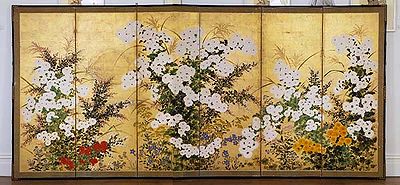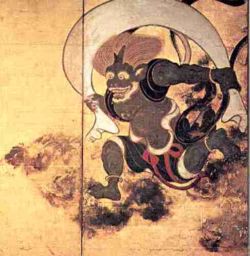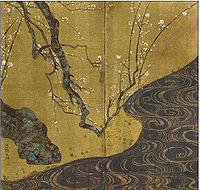
Rimpa school
Encyclopedia

Japanese painting
is one of the oldest and most highly refined of the Japanese visual arts, encompassing a wide variety of genres and styles. As with the history of Japanese arts in general, the long history of Japanese painting exhibits synthesis and competition between native Japanese aesthetics and adaptation of...
. It was created in 17th century Kyoto
Kyoto
is a city in the central part of the island of Honshū, Japan. It has a population close to 1.5 million. Formerly the imperial capital of Japan, it is now the capital of Kyoto Prefecture, as well as a major part of the Osaka-Kobe-Kyoto metropolitan area.-History:...
by Hon'ami Kōetsu
Honami Koetsu
was a Japanese craftsman, potter, lacquerer, and calligrapher, whose work is generally considered to have inspired the founding of the Rinpa school of painting.-Early life:...
(1558-1637) and Tawaraya Sōtatsu
Tawaraya Sotatsu
was a Japanese artist and also the co-founder of the Rimpa school of Japanese painting. Sōtatsu began to work as a fan-painter in Kyoto. Later, he rose to work for the court as a producer of fine decorated papers for calligraphy. He was highly influenced by Kyoto’s courtly culture...
(d. c.1643). Roughly fifty years later, the style was consolidated by brothers Ogata Kōrin
Ogata Korin
was a Japanese painter of the Rinpa school.-Early life:Kōrin was born in Kyoto, to a wealthy merchant who had a taste for the arts and is said to have given his son some elementary instruction therein...
(1658-1716) and Ogata Kenzan
Ogata Kenzan
, originally , and also known by the pseudonym Shisui, was a Japanese potter and painter, a younger brother of Ogata Korin. He was born in Kyoto in a rich marchant family and died in Edo . He had learned after the famous potter NONOMURA NINNSEI and made his own kiln. Since in 1712 a nobleman...
(1663-1743).
The term “Rimpa” itself is an amalgamation of the last syllable from “Kōrin” with the word for ' onMouseout='HidePop("40978")' href="/topics/Meiji_period">Meiji period
Meiji period
The , also known as the Meiji era, is a Japanese era which extended from September 1868 through July 1912. This period represents the first half of the Empire of Japan.- Meiji Restoration and the emperor :...
. Previously, the style was referred to variously as the , or , or the .
History

Nichiren
Nichiren was a Buddhist monk who lived during the Kamakura period in Japan. Nichiren taught devotion to the Lotus Sutra, entitled Myōhō-Renge-Kyō in Japanese, as the exclusive means to attain enlightenment and the chanting of Nam-Myōhō-Renge-Kyō as the essential practice of the teaching...
Buddhist
Buddhism
Buddhism is a religion and philosophy encompassing a variety of traditions, beliefs and practices, largely based on teachings attributed to Siddhartha Gautama, commonly known as the Buddha . The Buddha lived and taught in the northeastern Indian subcontinent some time between the 6th and 4th...
sect at Takagamine in northeastern Kyoto in 1615. Both the affluent merchant town elite and the old Kyoto aristocratic families
Kuge
The was a Japanese aristocratic class that dominated the Japanese imperial court in Kyoto until the rise of the Shogunate in the 12th century at which point it was eclipsed by the daimyo...
favored arts which followed classical traditions, and Kōetsu obliged by producing numerous works of ceramics, calligraphy
Japanese calligraphy
is a form of calligraphy, or artistic writing, of the Japanese language. For a long time, the most esteemed calligrapher in Japan had been Wang Xizhi, a Chinese calligrapher in the 4th century but after the invention of Hiragana and Katakana, the Japanese unique syllabaries, the distinctive...
and lacquerware
Maki-e
is Japanese lacquer sprinkled with gold or silver powder as a decoration using a makizutsu or a kebo brush. The technique was developed mainly in the Heian Period and blossomed in the Edo Period...
.
His collaborator, Tawaraya Sōtatsu maintained an atelier in Kyoto and produced commercial paintings such as decorative fans and folding screens
Byobu
are Japanese folding screens made from several joined panels bearing decorative painting and calligraphy, used to separate interiors and enclose private spaces, among other uses.- History :...
. Sōtatsu also specialized in making decorated paper with gold or silver backgrounds, to which Kōetsu assisted by adding calligraphy.
Both artists came from families of cultural significance; Kōetsu came from a family of swordsmiths who had served the imperial court and the great warlords, Oda Nobunaga
Oda Nobunaga
was the initiator of the unification of Japan under the shogunate in the late 16th century, which ruled Japan until the Meiji Restoration in 1868. He was also a major daimyo during the Sengoku period of Japanese history. His opus was continued, completed and finalized by his successors Toyotomi...
and Toyotomi Hideyoshi
Toyotomi Hideyoshi
was a daimyo warrior, general and politician of the Sengoku period. He unified the political factions of Japan. He succeeded his former liege lord, Oda Nobunaga, and brought an end to the Sengoku period. The period of his rule is often called the Momoyama period, named after Hideyoshi's castle...
, in addition to the Ashikaga
Ashikaga clan
The ' was a prominent Japanese samurai clan which established the Muromachi shogunate and ruled Japan from roughly 1336 to 1573.The Ashikaga were descended from a branch of the Minamoto clan, deriving originally from the town of Ashikaga in Shimotsuke province .For about a century the clan was...
shōguns. Kōetsu's father evaluated swords for the Maeda clan
Maeda clan
The was a branch of the Sugawara clan who descended from Sugawara no Kiyotomo and Sugawara no Michizane in the eighth and ninth centuries. It was one of the most powerful samurai families in Japan and they were second only to the Tokugawa clan in rice production and fief size...
, as did Kōetsu himself. However, Kōetsu was less concerned with swords as opposed to painting, calligraphy, lacquerwork, and the Japanese tea ceremony
Japanese tea ceremony
The Japanese tea ceremony, also called the Way of Tea, is a Japanese cultural activity involving the ceremonial preparation and presentation of matcha, powdered green tea. In Japanese, it is called . The manner in which it is performed, or the art of its performance, is called...
(he created several Raku Ware tea bowls.) His own painting style was flamboyant, recalling the aristocratic style of the Heian period
Heian period
The is the last division of classical Japanese history, running from 794 to 1185. The period is named after the capital city of Heian-kyō, or modern Kyōto. It is the period in Japanese history when Buddhism, Taoism and other Chinese influences were at their height...
.
Sōtatsu also pursued the classical Yamato-e
Yamato-e
Yamato-e is a style of Japanese painting inspired by Tang Dynasty paintings and developed in the late Heian period. It is considered the classical Japanese style...
genre as Kōetsu, but pioneered a new technique with bold outlines and striking color schemes. One his most famous works are the folding screens at Kennin-ji
Kennin-ji
, is a historic Zen Buddhist temple in Higashiyama, Kyoto, Japan, near Gion. It is considered to be one of the so-called Kyoto Gozan or "five most important Zen temples of Kyoto".-History:...
temple in Kyoto and at the Freer Gallery.
Later development

Edo period
The , or , is a division of Japanese history which was ruled by the shoguns of the Tokugawa family, running from 1603 to 1868. The political entity of this period was the Tokugawa shogunate....
, but was revived in the Genroku
Genroku
was a after Jōkyō and before Hōei. This period spanned the years from September 1688 through March 1704. The reigning emperor was .The years of Genroku are generally considered to be the Golden Age of the Edo Period. The previous hundred years of peace and seclusion in Japan had created relative...
era (1688-1704) by Ogata Kōrin and his younger brother Ogata Kenzan, sons of a prosperous Kyoto textile merchant. Kōrin's innovation was to depict nature as an abstract using numerous color and hue gradations, and mixing colors on the surface to achieve eccentric effects, as well as liberal use of precious substances like gold
Gold
Gold is a chemical element with the symbol Au and an atomic number of 79. Gold is a dense, soft, shiny, malleable and ductile metal. Pure gold has a bright yellow color and luster traditionally considered attractive, which it maintains without oxidizing in air or water. Chemically, gold is a...
and pearl
Pearl
A pearl is a hard object produced within the soft tissue of a living shelled mollusk. Just like the shell of a mollusk, a pearl is made up of calcium carbonate in minute crystalline form, which has been deposited in concentric layers. The ideal pearl is perfectly round and smooth, but many other...
.
His masterpiece
c. 1714/5, is now at the MOA Museum of Art
MOA Museum of Art
The is a private museum in the city of Atami, Japan. It was established in 1982 by the Mokichi Okada Association to house the art collection of their founder, multimillionaire and religious leader Mokichi Okada ....
in Atami, Shizuoka
Atami, Shizuoka
is a city located in the eastern end of Shizuoka Prefecture, Japan. As of February 2010, the city has an estimated population of 39,755 and a population density of 645 people per km². The total area is 61.56 km².-Geography:...
. A dramatic composition, it established the direction of Rimpa for the remainder of its history. Kōrin collaborated with Kenzan in painting designs and calligraphy on his brother's pottery. Kenzan remained as a potter in Kyoto until after Kōrin's death in 1716 when he began to paint professionally. Other Rimpa artists active in this period were Tatebayashi Kagei, Tawaraya Sori , Watanabe Shiko, Fukae Roshu and Nakamura Hochu.
Modern Rimpa
Rimpa was revived in 19th century Edo by Sakai HōitsuSakai Hoitsu
was a Japanese painter of the Rimpa school. He is famous for reviving the style and popularity of Ogata Kōrin, and for creating a number of reproductions of Kōrin's work.-Family background:...
(1761-1828), a Kanō school
Kano school
The ' is one of the most famous schools of Japanese painting. The Kanō school of painting was the dominant style of painting until the Meiji period.It was founded by Kanō Masanobu , a contemporary of Sesshū and student of Shūbun...
artist whose family had been one of Ogata Kōrin’s sponsors. Sakai published a series of 100 woodcut prints based on paintings by Kōrin, and his painting painted on the back of Kōrin’s "Wind and Thunder Gods screen" is now at the Tokyo National Museum
Tokyo National Museum
Established 1872, the , or TNM, is the oldest and largest museum in Japan. The museum collects, houses, and preserves a comprehensive collection of art works and archaeological objects of Asia, focusing on Japan. The museum holds over 110,000 objects, which includes 87 Japanese National Treasure...
.
Paintings of the early "Rimpa" artists were anthologized in small paperback booklets such as the Korin gafu (The Korin Picture Album) by Nakamura Hochu, first published in 1806. This was followed by an original work by Sakai Hoitsu called the Oson gafu, published in 1817.
Sakai had numerous students who carried the movement forward into the late 19th century, when it was incorporated into the Nihonga
Nihonga
or literally "Japanese-style paintings" is a term used to describe paintings that have been made in accordance with traditional Japanese artistic conventions, techniques and materials...
movement by Okakura Kakuzo
Okakura Kakuzo
was a Japanese scholar who contributed to the development of arts in Japan. Outside of Japan, he is chiefly remembered today as the author of The Book of Tea.-Biography:...
and other painters. The influence of Rimpa was strong throughout the early modern period, and even today Rimpa-style designs are popular. One later artist of note is Kamisaka Sekka
Kamisaka Sekka
was an important artistic figure in early twentieth-century Japan. Born in Kyoto to a Samurai family, his talents for art and design were recognized early. He eventually allied himself with the traditional Rimpa school of art. He is considered the last great proponent of this artistic tradition...
.
Style
Rimpa artists worked in various formats, notably screens, fans and hanging scrolls, woodblock printed books, lacquerware, ceramics, and kimonoKimono
The is a Japanese traditional garment worn by men, women and children. The word "kimono", which literally means a "thing to wear" , has come to denote these full-length robes...
textiles. Many Rimpa paintings were used on the sliding doors and walls (fusuma
Fusuma
In Japanese architecture, fusuma are vertical rectangular panels which can slide from side to side to redefine spaces within a room, or act as doors. They typically measure about wide by tall, the same size as a tatami mat, and are two or three centimeters thick...
) of noble homes.
Subject matter and style were often borrowed from Heian period traditions of yamato-e, with elements from Muromachi ink paintings, Chinese Ming dynasty
Ming Dynasty
The Ming Dynasty, also Empire of the Great Ming, was the ruling dynasty of China from 1368 to 1644, following the collapse of the Mongol-led Yuan Dynasty. The Ming, "one of the greatest eras of orderly government and social stability in human history", was the last dynasty in China ruled by ethnic...
flower-and-bird paintings, as well as Momoyama period Kanō school
Kano school
The ' is one of the most famous schools of Japanese painting. The Kanō school of painting was the dominant style of painting until the Meiji period.It was founded by Kanō Masanobu , a contemporary of Sesshū and student of Shūbun...
developments. The stereotypical standard painting in the Rimpa style involves simple natural subjects such as birds, plants and flowers, with the background filled in with gold leaf
Gold leaf
right|thumb|250px|[[Burnishing]] gold leaf with an [[agate]] stone tool, during the water gilding processGold leaf is gold that has been hammered into extremely thin sheets and is often used for gilding. Gold leaf is available in a wide variety of karats and shades...
. Emphasis on refined design and technique became more pronounced as the Rimpa style developed.
Notable Rimpa artists
- Hon'ami KōetsuHonami Koetsuwas a Japanese craftsman, potter, lacquerer, and calligrapher, whose work is generally considered to have inspired the founding of the Rinpa school of painting.-Early life:...
- Tawaraya SōtatsuTawaraya Sotatsuwas a Japanese artist and also the co-founder of the Rimpa school of Japanese painting. Sōtatsu began to work as a fan-painter in Kyoto. Later, he rose to work for the court as a producer of fine decorated papers for calligraphy. He was highly influenced by Kyoto’s courtly culture...
- Ogata KōrinOgata Korinwas a Japanese painter of the Rinpa school.-Early life:Kōrin was born in Kyoto, to a wealthy merchant who had a taste for the arts and is said to have given his son some elementary instruction therein...
- Ogata KenzanOgata Kenzan, originally , and also known by the pseudonym Shisui, was a Japanese potter and painter, a younger brother of Ogata Korin. He was born in Kyoto in a rich marchant family and died in Edo . He had learned after the famous potter NONOMURA NINNSEI and made his own kiln. Since in 1712 a nobleman...
- Sakai HōitsuSakai Hoitsuwas a Japanese painter of the Rimpa school. He is famous for reviving the style and popularity of Ogata Kōrin, and for creating a number of reproductions of Kōrin's work.-Family background:...
- Kamisaka SekkaKamisaka Sekkawas an important artistic figure in early twentieth-century Japan. Born in Kyoto to a Samurai family, his talents for art and design were recognized early. He eventually allied himself with the traditional Rimpa school of art. He is considered the last great proponent of this artistic tradition...

